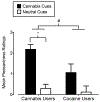Attentional bias to cannabis cues in cannabis users but not cocaine users
- PMID: 30176501
- PMCID: PMC6191321
- DOI: 10.1016/j.addbeh.2018.08.023
Attentional bias to cannabis cues in cannabis users but not cocaine users
Abstract
Attentional bias to drug cues has been associated with the problematic use of drugs, including cannabis. The cognitive mechanisms underlying this bias are not fully understood. The purpose of this study was to determine whether cannabis-cue attentional bias is associated with disruptions in attentional processing. To this end, a novel cannabis-cue visual probe task that incorporated eye tracking technology and attention-based metrics derived from signal detection theory was administered to seventeen individuals who reported daily/near-daily cannabis use. Seventeen individuals with cocaine use disorder were also enrolled as a clinical-control group. Cannabis and neutral images were briefly presented side-by-side on a computer screen, followed by the appearance of a "go" or "no-go" target upon offset of both images to permit assessment of attention-based performance. Cannabis users exhibited attentional bias to cannabis cues, as measured by fixation time and response time, but not cue-dependent disruptions on subsequent attentional performance. Cocaine users did not display an attentional bias to cannabis cues but did display poorer attentional performance relative to cannabis users. These results indicate that attentional bias to cannabis cues is selective to cannabis use history and not associated with impaired attentional processing.
Keywords: Attentional bias; Cannabis; Cocaine; Signal detection; Substance use.
Copyright © 2018 Elsevier Ltd. All rights reserved.
Conflict of interest statement
Conflicts of Interest
The authors declare no conflicts of interest relevant to this work. This manuscript represents original research and all applicable subject protection guidelines and regulations were followed in the conduct of the research.
Figures




References
-
- American Psychiatric Association, 2000. Diagnostic and statistical manual of mental disorders, fourth ed. American Psychiatric Association, Washington D.C. Text Revision.
-
- Benjamini Y, Hochberg Y, 1995. Controlling the false discovery rate: a practical and powerful approach to multiple testing. J Roy Statist Soc, Ser B. 57(1):289–300.
-
- Bradley B, Field M, Mogg K, De Houwer J, 2004. Attentional and evaluative biases for smoking cues in nicotine dependence: component processes of biases in visual orienting. Behav Pharmacol February;15(1):29–36. - PubMed
Publication types
MeSH terms
Grants and funding
LinkOut - more resources
Full Text Sources
Other Literature Sources
Medical

